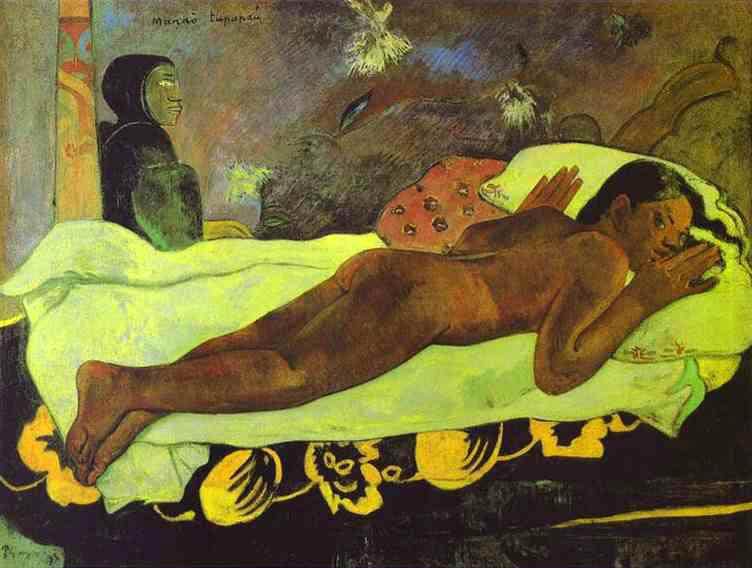| Spirit of the Dead Watching | |
|---|---|
 |
|
| Artist | Paul Gauguin |
| Year | 1892 |
| Medium | Oil on canvas |
| Dimensions | 28 1/2 x 36 3/8 in. 72.4 x 92.4 cm |
| Location | Albright Knox Art Gallery in Buffalo, New York |
| Famous Paintings by Paul Gauguin | |
| Spirit of the Dead Watching, 1892 | |
| Where Do We Come From? What Are We? Where Are We Going?, 1897-1898 | |
| The Yellow Christ, 1889 | |
| The Green Christ, 1889 | |
| Tahitian Women on the Beach, 1891 | |
| Vision After the Sermon, 1888 | |
| Complete Works |
Spirit of the Dead Watching was completed in 1892 as an oil canvas on burlap, inspired by the period in which the artist visited Tahiti, where he met his wife, Tehura. The image presents a nude girl laid down on a bed, characterized by formal lines, mild eroticism, and freight. In the background, right next to the woman’s bed, the spirit of death watches over her naked body. Terrified by the ghostly presence, the woman’s face reveals her intense emotions as seen by the artist. According to the island’s mythology, the symbolism of the painting can be interpreted in two ways. One description of the scene assumes that the young woman is thinking of the deathly spirit. The second interpretation claims that the spirit of death is thinking of the girl.
About Gauguin
Eugene Henri Paul Gauguin was born on June 7, 1848 in Paris, France. During his life as a teenager, the artist attended to multiple local schools but failed to enroll in any university. Gauguin tried multiple jobs prior to the discovery of his artistic talent. In 1873, while he was working as a stockbroker, Paul began painting in his free time. He found refuge in folk art and Japanese prints, evolving into Cloisonnism. His work is mainly characterized by flat forms with dark contours. Colors are usually separated by dark lines, eliminating subtle gradations.
Art Style
The spirit takes the form of an old woman dressed in black with phosphorescent eyes. Both characters are represented using flat forms and dark contours. Ambiguous shapes, colors and the phosphorescent shapes deepen the enigmatic atmosphere of the painting. Gauguin’s post-Impressionist style is imprinted into the shapes and dark tone of the painting. At the same time, the artists make use of high contrasts to focus the attention of the viewer on the symbolic elements. The importance of Spirit of the Dead Watching to the artist was also revealed by including it in his self-portrait.